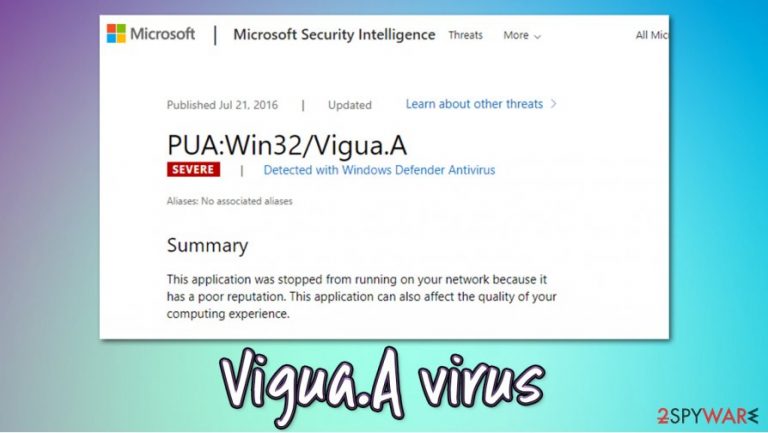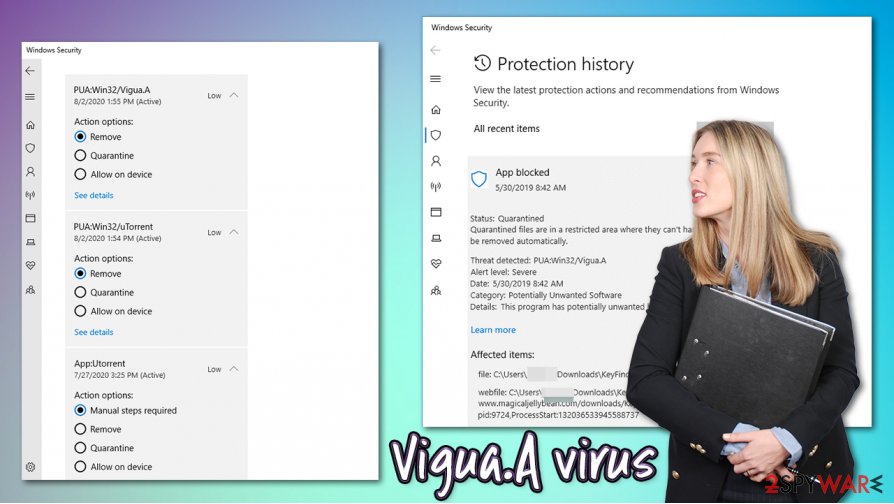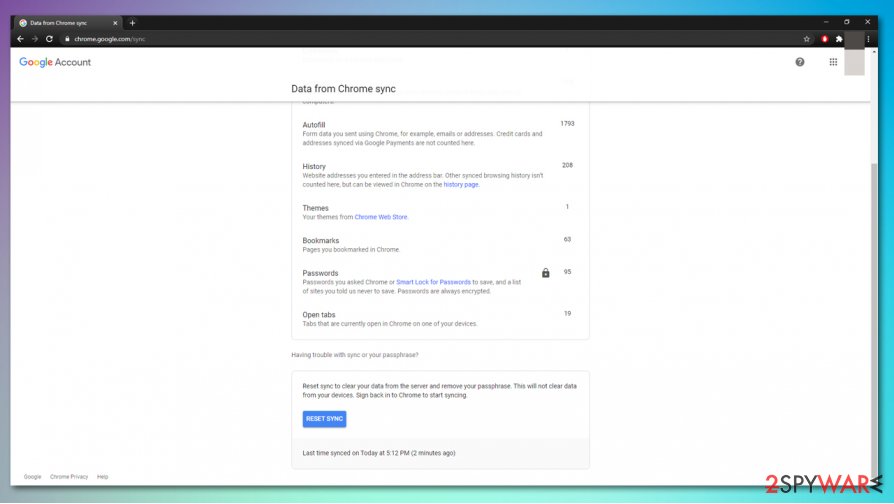Vigua.A virus (Removal Instructions) - Free Guide
Vigua.A virus Removal Guide
What is Vigua.A virus?
Vigua.A virus – an intrusive adware infection that users struggle to get rid of

Vigua.A virus, otherwise known as PUA:Win32/Vigua.A, is a detection name used by Windows Defender security software to flag potentially unwanted programs. These apps typically travel within software bundles or fake Flash Player update prompts, which results in unintentional installation from users' point of view.
Once inside the system, Vigua.A virus might perform a variety of system and browser modifications. For example, the homepage and new tab address might be changed to something else, and all the searchers might be redirected to Yahoo. Adware is typically compiled in a way that allows it to engage in intrusive ad campaigns. Hence, the infected users are accustomed to popups, deals, offers, in-text links, auto-play, and similar advertisements that can greatly diminish the web browsing experience. In the background, Win32/Vigua.A might also track user information, which sometimes may include personal details.
| Name | Vigua.A virus, PUA:Win32/Vigua.A |
| Type | Potentially unwanted application, adware |
| Danger level | Medium. It can infect any systems and populate advertisements on all the web browsers and track user data; it can also use persistence mechanisms that prevent easy elimination |
| Distribution | Software bundle packages, fake updates, misleading advertisements, software cracks |
| Symptoms | Unexpected changes to the web browser's homepage and new tab address; intrusive advertisements; slow web browser; PUA:Win32/Vigua.A popup shows up despite the security software claiming it's been deleted |
| Removal | To eliminate the infection, simply allow Windows Defender to move it to quarantine; in case the detection returns, perform scans with alternative security programs (SpyHunter 5Combo Cleaner, Malwarebytes, for example) |
| Further steps | In case the detection does not go away, and you are spammed by your security software, it might be a browser or Google account syncing problem. In such a case, reset your web browser and sync, and later perform a scan with FortectIntego for best results |
Potentially unwanted programs are distributed in a way that typically results in an unintentional installation. The most commonly used method is software bundling, where several applications are compiled into a single installer and optional ones are deliberately hidden from careless users' sight. Thus, to avoid future encounters and Vigua.A virus removal problems, you should install applications carefully and never install programs offered via fake Flash Player installers.[1]
Adware programs such as Vigua.A virus are designed to perform background activities in order to monetize users' clicks. For the purpose, authors of a potentially unwanted program employ a variety of methods that would allow for a maximum monetization:
- Distribute apps in various deceptive ways;
- Change web browser's homepage and new tab to some other URL;
- Redirect all searches to Yahoo or a dubious provider;
- Insert sponsored links into search results;
- Display intrusive ads on all visited websites;
- Redirect to malicious domains;
- Track users' browsing data to sell it to third-parties.
Unfortunately, these are just a few traits that adware might possess. Some PUPs can be much more dangerous – they might set the “Managed by your organization” feature in order to prevent users from easy app termination. Others might straight out steal sensitive information such as banking details – Adload adware family does precisely that wit the help of extensions such as ExploreParameter, OperativeFraction, SectionBrowser, and many others.
To make matters more clear, PUA:Win32/Vigua.A is a heuristic detection, which indicates that it is not the name of the virus itself but rather a detection name given to apps the expose certain malicious behavior. Thus, there could be many different PUPs under the mantle of this name.
Usually, when an anti-malware detects something, it delivers the detection to quarantine, later to be removed automatically. Unfortunately, users who reported Vigua.A virus popups claimed that they come back on a regular basis. This behavior is typical to PUPs that use various persistence mechanisms in order to stay on the system as long as possible to deliver ads to users, earning profits in the process.

If you are one of such users, you should remove Vigua.A virus by scanning the device with alternative security software – experts recommend Malwarebytes or SpyHunter 5Combo Cleaner, although other reputable tools should do the job as well. You can also look for potentially unwanted programs via the Control Panel (Windows) or Applications folder (Mac) and uninstall PUPs manually – we provide the instructions below.
In case scanning the machine with alternative software did not help, the issue might lie within Google account and its syncing problems. To find out more about how to reset Chrome sync, refer to the bottom section below.
Watch out for potentially unwanted programs – install software from third parties carefully
Potentially unwanted programs are typically installed behind users' backs with the help of various tricks employed by its authors or distributors. Most commonly, software bundling is used, as it is very effective – users often rush through the installation steps of new software and don't pay attention to important clues that might sometimes not be so apparent.
First of all, you should install applications from official sources if possible – this would usually eliminate PUP infiltration altogether. The unwanted apps downloaded from official sources such as browser extensions are typically very easy to eliminate and do not cause any major dangers.
Third-party sites often use bundles as one of the main ways to monetize, which means that it is in their best interest to make as many users as possible to install additional software. Unfortunately, such apps are often useless, intrusive, and even malicious. To avoid installation of PUPs, always pay close attention to the installation process:
- Pick Advanced/Custom settings instead of Recommended/Quick ones;
- Remove all ticks from checkboxes that offer additional programs;
- Watch out for misplaced buttons and misleading offers you could encounter on the way.
Also, many PUPs can be downloaded along with pirated software installers or software cracks. As a general rule, security experts[2] recommend staying away from such high-risk websites, as downloading software from there might result in malware infection, such as Kasp ransomware.
A method that could help you remove Vigua.A virus popups once and for all
PUA:Win32/Vigua.A removal might be a real pain to many users, as Windows Defender often fails to eliminate it completely – or at least it might seem so. Some users reported that they received the detection along with uTorrent client – this app is often used for illegal software installer downloads. Despite being legitimate, it has been recently bundled with potentially harmful software and is not recommended to use.
As previously mentioned, you can try to remove Vigua.A virus by scanning the machine with alternative security software. Unfortunately, many users claimed that, after trying other tools, the virus came back, and Windows Defender kept flagging the issue non-stop.[3]

Vigua.A virus detection might sometimes be related to your Google account. Some synced items might remain on Google's servers, and no matter if your anti-malware removes malicious components that are placed on your system through your account, they will come back as soon as your use your browser again.
Therefore, the best solution is to reset your web browser, as well as Chrome Sync. For that, access the synced items page, and click “Reset Sync” at the bottom. Make sure you do this before you reset your browser.
You may remove virus damage with a help of FortectIntego. SpyHunter 5Combo Cleaner and Malwarebytes are recommended to detect potentially unwanted programs and viruses with all their files and registry entries that are related to them.
Getting rid of Vigua.A virus. Follow these steps
Uninstall from Windows
To uninstall unwanted applications from Windows, proceed with these steps:
Instructions for Windows 10/8 machines:
- Enter Control Panel into Windows search box and hit Enter or click on the search result.
- Under Programs, select Uninstall a program.

- From the list, find the entry of the suspicious program.
- Right-click on the application and select Uninstall.
- If User Account Control shows up, click Yes.
- Wait till uninstallation process is complete and click OK.

If you are Windows 7/XP user, proceed with the following instructions:
- Click on Windows Start > Control Panel located on the right pane (if you are Windows XP user, click on Add/Remove Programs).
- In Control Panel, select Programs > Uninstall a program.

- Pick the unwanted application by clicking on it once.
- At the top, click Uninstall/Change.
- In the confirmation prompt, pick Yes.
- Click OK once the removal process is finished.
Delete from macOS
macOS users should follow these instructions if they want to eliminate unwanted apps:
Remove items from Applications folder:
- From the menu bar, select Go > Applications.
- In the Applications folder, look for all related entries.
- Click on the app and drag it to Trash (or right-click and pick Move to Trash)

To fully remove an unwanted app, you need to access Application Support, LaunchAgents, and LaunchDaemons folders and delete relevant files:
- Select Go > Go to Folder.
- Enter /Library/Application Support and click Go or press Enter.
- In the Application Support folder, look for any dubious entries and then delete them.
- Now enter /Library/LaunchAgents and /Library/LaunchDaemons folders the same way and terminate all the related .plist files.

Remove from Microsoft Edge
Delete unwanted extensions from MS Edge:
- Select Menu (three horizontal dots at the top-right of the browser window) and pick Extensions.
- From the list, pick the extension and click on the Gear icon.
- Click on Uninstall at the bottom.

Clear cookies and other browser data:
- Click on the Menu (three horizontal dots at the top-right of the browser window) and select Privacy & security.
- Under Clear browsing data, pick Choose what to clear.
- Select everything (apart from passwords, although you might want to include Media licenses as well, if applicable) and click on Clear.

Restore new tab and homepage settings:
- Click the menu icon and choose Settings.
- Then find On startup section.
- Click Disable if you found any suspicious domain.
Reset MS Edge if the above steps did not work:
- Press on Ctrl + Shift + Esc to open Task Manager.
- Click on More details arrow at the bottom of the window.
- Select Details tab.
- Now scroll down and locate every entry with Microsoft Edge name in it. Right-click on each of them and select End Task to stop MS Edge from running.

If this solution failed to help you, you need to use an advanced Edge reset method. Note that you need to backup your data before proceeding.
- Find the following folder on your computer: C:\\Users\\%username%\\AppData\\Local\\Packages\\Microsoft.MicrosoftEdge_8wekyb3d8bbwe.
- Press Ctrl + A on your keyboard to select all folders.
- Right-click on them and pick Delete

- Now right-click on the Start button and pick Windows PowerShell (Admin).
- When the new window opens, copy and paste the following command, and then press Enter:
Get-AppXPackage -AllUsers -Name Microsoft.MicrosoftEdge | Foreach {Add-AppxPackage -DisableDevelopmentMode -Register “$($_.InstallLocation)\\AppXManifest.xml” -Verbose

Instructions for Chromium-based Edge
Delete extensions from MS Edge (Chromium):
- Open Edge and click select Settings > Extensions.
- Delete unwanted extensions by clicking Remove.

Clear cache and site data:
- Click on Menu and go to Settings.
- Select Privacy, search and services.
- Under Clear browsing data, pick Choose what to clear.
- Under Time range, pick All time.
- Select Clear now.

Reset Chromium-based MS Edge:
- Click on Menu and select Settings.
- On the left side, pick Reset settings.
- Select Restore settings to their default values.
- Confirm with Reset.

Remove from Mozilla Firefox (FF)
Remove dangerous extensions:
- Open Mozilla Firefox browser and click on the Menu (three horizontal lines at the top-right of the window).
- Select Add-ons.
- In here, select unwanted plugin and click Remove.

Reset the homepage:
- Click three horizontal lines at the top right corner to open the menu.
- Choose Options.
- Under Home options, enter your preferred site that will open every time you newly open the Mozilla Firefox.
Clear cookies and site data:
- Click Menu and pick Settings.
- Go to Privacy & Security section.
- Scroll down to locate Cookies and Site Data.
- Click on Clear Data…
- Select Cookies and Site Data, as well as Cached Web Content and press Clear.

Reset Mozilla Firefox
If clearing the browser as explained above did not help, reset Mozilla Firefox:
- Open Mozilla Firefox browser and click the Menu.
- Go to Help and then choose Troubleshooting Information.

- Under Give Firefox a tune up section, click on Refresh Firefox…
- Once the pop-up shows up, confirm the action by pressing on Refresh Firefox.

Remove from Google Chrome
Reset Google Chrome to get rid of PUA:Win32/Vigua.A detection after you reset Google Sync.
Delete malicious extensions from Google Chrome:
- Open Google Chrome, click on the Menu (three vertical dots at the top-right corner) and select More tools > Extensions.
- In the newly opened window, you will see all the installed extensions. Uninstall all the suspicious plugins that might be related to the unwanted program by clicking Remove.

Clear cache and web data from Chrome:
- Click on Menu and pick Settings.
- Under Privacy and security, select Clear browsing data.
- Select Browsing history, Cookies and other site data, as well as Cached images and files.
- Click Clear data.

Change your homepage:
- Click menu and choose Settings.
- Look for a suspicious site in the On startup section.
- Click on Open a specific or set of pages and click on three dots to find the Remove option.
Reset Google Chrome:
If the previous methods did not help you, reset Google Chrome to eliminate all the unwanted components:
- Click on Menu and select Settings.
- In the Settings, scroll down and click Advanced.
- Scroll down and locate Reset and clean up section.
- Now click Restore settings to their original defaults.
- Confirm with Reset settings.

Delete from Safari
Remove unwanted extensions from Safari:
- Click Safari > Preferences…
- In the new window, pick Extensions.
- Select the unwanted extension and select Uninstall.

Clear cookies and other website data from Safari:
- Click Safari > Clear History…
- From the drop-down menu under Clear, pick all history.
- Confirm with Clear History.

Reset Safari if the above-mentioned steps did not help you:
- Click Safari > Preferences…
- Go to Advanced tab.
- Tick the Show Develop menu in menu bar.
- From the menu bar, click Develop, and then select Empty Caches.

After uninstalling this potentially unwanted program (PUP) and fixing each of your web browsers, we recommend you to scan your PC system with a reputable anti-spyware. This will help you to get rid of Vigua.A registry traces and will also identify related parasites or possible malware infections on your computer. For that you can use our top-rated malware remover: FortectIntego, SpyHunter 5Combo Cleaner or Malwarebytes.
How to prevent from getting adware
Access your website securely from any location
When you work on the domain, site, blog, or different project that requires constant management, content creation, or coding, you may need to connect to the server and content management service more often. The best solution for creating a tighter network could be a dedicated/fixed IP address.
If you make your IP address static and set to your device, you can connect to the CMS from any location and do not create any additional issues for the server or network manager that needs to monitor connections and activities. VPN software providers like Private Internet Access can help you with such settings and offer the option to control the online reputation and manage projects easily from any part of the world.
Recover files after data-affecting malware attacks
While much of the data can be accidentally deleted due to various reasons, malware is one of the main culprits that can cause loss of pictures, documents, videos, and other important files. More serious malware infections lead to significant data loss when your documents, system files, and images get encrypted. In particular, ransomware is is a type of malware that focuses on such functions, so your files become useless without an ability to access them.
Even though there is little to no possibility to recover after file-locking threats, some applications have features for data recovery in the system. In some cases, Data Recovery Pro can also help to recover at least some portion of your data after data-locking virus infection or general cyber infection.
- ^ Lindsey O'Donnell. Fake Adobe Flash Updates Hide Malicious Crypto Miners. Threat Post. The first stop for security news.
- ^ Usunwirusa. Usunwirusa. Cybersecurity advice and malware insights.
- ^ Windows 10 Virus? Help?. LinusTechTips. Technology website forums.
